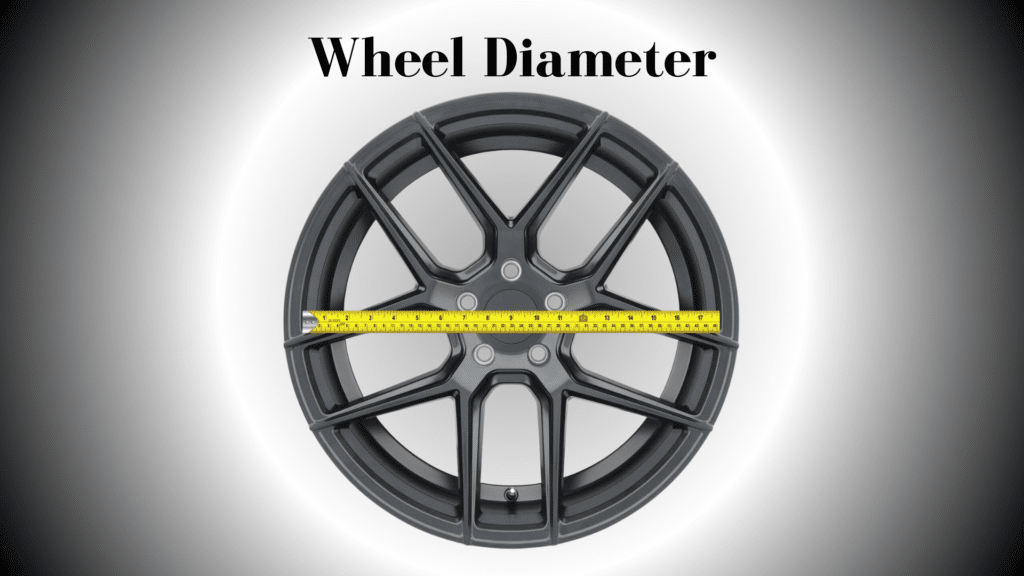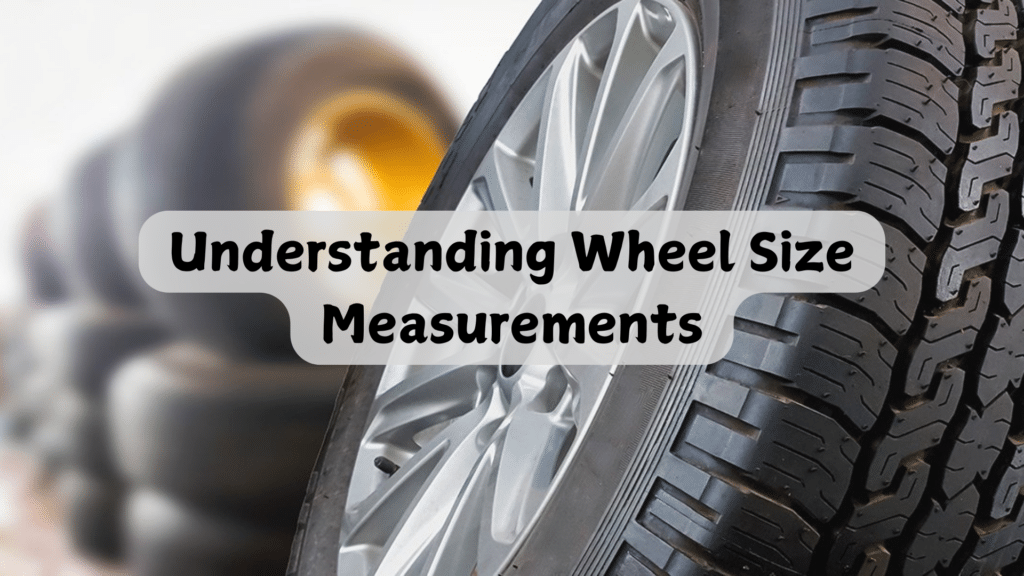Have you ever stared at wheel-size numbers and felt confused?
You’re not alone.
Getting the right wheels for your car is more than just picking what looks good – it’s about your safety and how well your car runs.
I’ve worked at tire shops for years, and I’ve seen what happens when people get the wrong wheel sizes.
From poor handling to damaged suspension, the problems can be serious (and expensive).
In this guide, I’ll break down:
- How to read wheel measurements
- What the numbers actually mean
- Which sizes work for your car
By the end of this article, you will know exactly how to choose the right wheels for your car.
Let’s get started.
Why Wheel Size Matters

Let me tell you something important: wheel size affects almost everything about your car’s performance.
I see this every day at my shop.
Your comfort comes first.
Bigger wheels with low-profile tires mean you’ll feel every bump on the road.
Smaller wheels with more tire cushioning give you a smoother ride. It’s that simple.
Wrong sizes cause real problems:
- Your speedometer will show incorrect speeds
- Your car will use more gas than it should
- Your brakes might wear out faster
After fixing hundreds of cars, I learned that even a small change in wheel size can make a big difference.
Think of it like shoes—when they’re the wrong size, every step feels off.
I once had a customer who switched to wheels that were too big.
Their gas bills went up by $30 a month, and their car didn’t turn as well as it used to.
We fixed it by going back to the right size.
The bottom line?
The right wheel size keeps your car running smoothly, saves you money, and keeps you safe.
Breaking Down Wheel Size Measurements
I know those numbers on your wheels might look like a secret code, but they’re really just three simple measurements you need to understand.
Let me explain them to you.
The three main numbers mean:
- Wheel diameter – how big the wheel is across the middle
- Wheel width – how wide the wheel is from side to side
- Offset – where the wheel sits in relation to your car
Let’s look at a common example: 17 x 7.5 ET45
The first number (17)
tells you the wheel diameter in inches.
This is what most people think of as “wheel size.”
You’ll need this to match your tire size.
The second number (7.5)
shows the width in inches. This affects how wide your tires can be.
Think of it like this: wider wheels usually mean better grip, but they also cost more.
The last part (ET45)
is the offset. It tells you how far in or out your wheel sits.
The wrong offset can make your wheels stick out too far or rub against your car.
I always tell my customers to write down these numbers before buying new wheels.
They’re like a recipe—if one measurement is wrong, nothing will fit right.
Remember: your car was built for specific wheel sizes.
You can change them a little, but staying close to these numbers keeps your car safe and running well.
Understanding Diameter, Width, and Offset
Let me show you how each wheel measurement affects your car in real ways.
I’ll use examples from my daily work at the shop.
Diameter – The Big Picture
When you change wheel diameter, you change how high your car sits.
Moving from 16-inch to 18-inch wheels?
Your car will sit about an inch higher. This means:
- Your car’s center of gravity changes
- You might need to duck more when entering parking garages
- Your speedometer reading might be off
Width – Your Grip on the Road
Think of width like your shoes – wider means more contact with the ground.
A wider wheel:
- Gives you better control when turning
- Helps you stop faster
- Could make your steering feel heavier
Here’s a tip from my experience: going too wide can make your tires wear out faster on the edges.
Offset – Finding the Sweet Spot
The offset determines if your wheels stick in or out.
Getting this wrong is like wearing your shoes on the wrong feet. I’ve seen cars with:
- Tires rubbing against the body (offset too low)
- Poor handling (offset too high)
- Uneven tire wear (wrong offset)
Remember: these three measurements work together.
When you change one, you affect how the others work too.
Always check your car’s manual for the right numbers.
How to Read Wheel Size Markings
Let me teach you to read wheel markings like a pro.
I’ll use what I see every day at my shop: “18×8.5J ET35.” Let’s break this down into parts you can understand.
First Number (18)
- This is your wheel’s diameter in inches
- You’ll find it stamped on the back of your wheel
- It’s always the first number you see
Middle Part (8.5J)
- 8.5 tells you how wide the wheel is in inches
- The “J” shows the shape of the wheel’s rim edge
- Most cars use J-type wheels, so don’t worry about this letter too much
Last Part (ET35)
- ET means how far your wheel sits from your car’s body
- 35 is the measurement in millimeters
- A lower number means the wheel sits further out
Where to Find These Numbers:
Look for these markings:
- On the back of the wheel
- Stamped into the metal
- Usually near the center
The Truth About Compatibility I check these numbers every day to ensure that the wheels fit correctly.
You need all three numbers to match what your car needs.
Even if one number is wrong, you could have problems.
After working on thousands of cars, I’ve noticed clear patterns in wheel sizes.
Let me show you what works for different types of cars.
Small Cars and Sedans
- Most use 15 to 17-inch wheels
- Common width: 6 to 7.5 inches
- Perfect for daily driving and good gas mileage
I often tell sedan owners to stick with these sizes. They’re cheaper to replace and give a smooth ride.
SUVs and Crossovers
- Usually, fit 17 to 19-inch wheels
- Width ranges from 7 to 8.5 inches
- Built for a mix of comfort and control
Last month, I helped an SUV owner who went too big with 22-inch wheels.
Their ride got rough, and their gas bills shot up.
We switched back to 18-inch wheels, and they loved the difference.
Sports Cars
- Often use 18 to 20-inch wheels
- Wider wheels: 8 to 10 inches
- Made for better handling at high speeds
Trucks and Large SUVs
- Range from 17 to 20 inches
- Extra wide: 8 to 9.5 inches
- Built to handle heavy loads
Here’s what I’ve learned: bigger isn’t always better.
Your car was designed for specific wheel sizes for good reasons. Smaller wheels often mean:
- Better gas mileage
- Smoother rides
- Cheaper tires
- Less road noise
Remember: check your car’s manual before making any changes. It lists the sizes that work best for your car.
How Wheel Size Affects Performance
In my 15 years working with cars, I’ve seen how wheel size affects a car’s performance.
Let me share what really happens when you change your wheel size.
1. Bigger Wheels
Going up in size affects your car in ways you’ll notice right away.
Your car might look better, but there’s more to think about.
I’ve tested hundreds of cars with different wheel sizes.
Bigger wheels make your car respond faster when you turn.
They also help you stop quicker because there’s more rubber touching the road.
2. The Price of Going Bigger
But here’s what many shops won’t tell you: larger wheels make your engine work harder.
Your car needs more power to turn bigger, heavier wheels.
This means you’ll use more gas.
I’ve measured it: Upgrading your wheel size by just two inches can decrease your gas mileage by 1-2 miles per gallon.
3. Smaller Wheels
Going smaller has its good points, too.
Your car will speed up faster because the wheels are lighter. You’ll save money on gas.
The ride will feel smoother because there’s more tire to soak up bumps.
But you might notice your car doesn’t grip the road as well in sharp turns.
What I Tell My Customers:
Stay within one inch of your car’s original wheel size.
This gives you the best mix of looks and performance.
I’ve seen too many cars ruined by wheels that were too big or too small.
Remember: the best wheel size balances what you want your car to do with how you want it to feel.
Before making a change, consider how you use your car every day.
Tips for Buying New Wheels
After selling wheels for 15 years, I know what works and what doesn’t.
Here’s what you need to check before spending your money on new wheels.
1. Check Your Car’s Specs First
Pull out your owner’s manual or look inside your driver’s door.
Write down all the wheel sizes that fit your car.
I always tell my customers that these numbers are their shopping guides.
They prevent them from buying wheels that won’t fit.
2. Think About Weight
The weight of your wheels matters more than most people know.
Light wheels help your car run better. Steel wheels are strong but heavy.
Alloy wheels cost more but weigh less.
I’ve seen cars become much faster just by switching to lighter wheels.
3. Look at Build Quality
Not all wheels are built the same way.
Pick a wheel maker with a good name.
I test wheels by looking at the finish quality and checking for even weight balance.
Good wheels have clear markings and smooth edges.
4. Match Your Driving Style
Tell me how you drive, and I’ll tell you what wheels to buy.
Do you drive mostly in the city?
You need strong wheels that can take hits from curbs and potholes.
Long highway trips?
Look for wheels that help save gas.
5. Real-World Testing
Before you buy, I suggest:
- Get the exact measurements of the wheels
- Ask about the return policy
- Check if your current tires will fit
- Make sure your car has enough space for the wheels
- Find out how much the wheels weigh
6. Price vs. Quality
The cheapest wheels often cost more in the long run.
I’ve seen cheap wheels crack and bend.
But you don’t need the most expensive ones either.
Mid-range wheels from good brands usually give you the best value.
Conclusion
Now you know the basics of wheel sizes and what they mean for your car.
I’ve shown you how to read those numbers on your wheels and what happens when you change sizes.
After years in the shop, I have this best advice: check your measurements twice before buying new wheels.
Look at your car’s manual, write down the numbers, and take pictures of your current wheels.
Remember, small changes in wheel size can make a big difference in how your car runs.
If you’re still unsure, talk to a wheel expert at your local shop.
They can help you find the right fit. Don’t rush this decision.
The right wheels will keep you safe and make your car run its best.
Need more help?
Leave a comment below with your questions.
Frequently Asked Questions
Can I Mix Different Wheel Sizes On My Car?
No, using different wheel sizes can damage your car’s differential and cause handling problems.
Unless specified by the manufacturer, always use the same-size wheels in all positions.
How Often Should I Replace My Wheels?
Check your wheels yearly for cracks, bends, and damage.
Most wheels last 5-7 years with normal use, but if you spot any damage, replace them immediately.
What’s The Safest Amount I Can Upsize My Wheels?
Keep your wheel size within one inch of the factory’s.
Going beyond that often requires suspension changes and can affect your car’s safety systems.
Do Weather Conditions Affect Which Wheel Size I Should Choose?
Yes.
Smaller wheels with bigger tire sidewalls perform better in snow and rain.
And they are less likely to be damaged by potholes in cold weather.
Should My Summer And Winter Wheels Be The Same Size?
Winter wheels can be slightly smaller than summer wheels.
This allows you to use tires with taller sidewalls, which better handle snow and ice.


